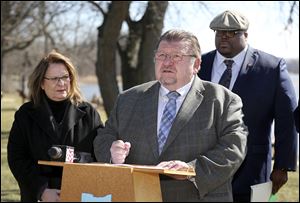
Algae termed environmental justice issue
Trump plan called ‘travesty’
3/23/2017While several familiar policy groups and elected officials are gearing up for the 2017 algae watch with spring runoff season’s arrival, an urban advocacy group’s spokesman wants to underscore how Lake Erie’s condition is an environmental-justice issue for Toledo’s poor and disadvantaged.
Much like the high-profile contamination of lead pipes in Flint, Mich., officials must recognize that many central city residents are disproportionately affected by anything from asbestos to western Lake Erie algae, Keith Jordan, development director for JLJ Vision Outreach, said Wednesday along the Maumee River shoreline while joining others at a news conference inside Side Cut Metropark.

Toledo City Councilman Peter Ujvagi, with Lucas County Commissioner Carol Contrada, and Keith Jordan, director of development for JLJ Vision Outreach, talks about the goal of eradicating Lake Erie algal toxins.
“Urban residents are often most vulnerable. They also represent the communities that will be hit hardest by climate change and algal blooms, placing them on the front lines of the scramble to adapt and mitigate its impacts,” Mr. Jordan said. “Ohio lawmakers must take immediate action to ensure the health and safety of area residents.”
Mr. Jordan said his group “definitely” plans to become more active in promoting that message, calling the current situation a result of “decades of bad environmental policy” in which agricultural and sewage-treatment costs were put ahead of public health.
“We’ve seen too many times it quiets down after a while, but this is a [continuous] public-health issue for people of urban areas,” Mr. Jordan told The Blade after the event.
Joining him at the news conference were Toledo City Councilman Peter Ujvagi — who said it is imperative for the city to continue to “do its part” by completing improvements to its sewage system and upgrades to its Collins Park Water Treatment Plant — along with Lucas County Commissioner Carol Contrada, and Nick Mandros, newly hired northwest Ohio policy coordinator for the state’s largest environmental group, the Ohio Environmental Council.
“There’s more urban areas need to do and we’re committed to doing that,” Mr. Ujvagi said, while also noting scientific data show most of the problem comes from northwest Ohio farm runoff.
He said the Trump Administration’s plan to gut budgets for the U.S. Environmental Protection Agency, the National Oceanic and Atmospheric Administration, and other agencies with major roles in Great Lakes research is “a travesty.”
The administration’s plan would not only reduce EPA’s overall budget by about 30 percent, but also would end federal funding for the agency’s Great Lakes Restoration Initiative, for which Congress has typically provided about $300 million a year. Ohio Sea Grant and Ohio State University’s Stone Laboratory, which anchor much of Ohio’s Lake Erie research, also would lose most or all of their federal funding.
“We can’t let our elected officials turn their back on our natural resources,” Mr. Ujvagi said.
Ms. Contrada said the proposed cuts fail to respect what she and others believe is a human right to clean water.
“Water is really what’s made civilizations flourish,” Ms. Contrada said.
She echoed comments made Tuesday night at Otsego High School by an East Coast consultant who has spent 45 years working on Chesapeake Bay agricultural runoff.
Verna Harrison, principal of Verna Harrison Associates LLC, told more than 100 people — many of them farmers — that the total maximum daily load, or TMDL, program put into effect a few years ago for the six-state Chesapeake Bay watershed hasn’t resulted in onerous regulations as many feared.
She cited a well-circulated quote by former U.S. Department of Agriculture Secretary Earl “Buddy” Hance, a Chesapeake Bay area farmer and former Maryland agricultural department chief, who said the TMDL program there “did not make or break farmers’ operations.”
The Chesapeake Bay basin, with its 17 million people, has the nation’s largest TMDL program — offered now as a model for western Lake Erie. But the Kasich administration has resisted those efforts, stating it has concerns over designating this area as impaired in order to start a TMDL program.
“We can’t be afraid of regulation,” Ms. Contrada said.
Also at Wednesday’s news conference, Mr. Mandros said the value of fishing, boating, and other recreation should be considered in addition to the more obvious concerns about drinking water.
“A river holds a connection to a community,” he said. “Toxic algae will continue to threaten drinking water until we get serious about it.”
Contact Tom Henry at: thenry@theblade.com, 419-724-6079, or via Twitter @ecowriterohio.